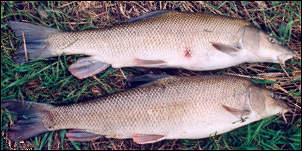A barbel cannot disguise its intentions: the torpedo shape and paddle-like fins are obvious clues to its way of life. In the fast-flowing water for which it is so perfectly adapted, the streamlined form allows the fish to hug the bottom and hold station against powerful flows. The paired pectoral fins serve as anchoring devices and current deflectors. These body features are largely responsible for the barbel’s well-known fighting abilities. The description ‘beauty and the beast’ was never more apt!

Easy to identify
The only fish with which barbel, when small, could be confused are gudgeon. Other than the colour differences – gudgeon are more mottled – the giveaway feature is the position of four fleshy barbules around their mouths. In barbel, there are two at the junction of the thick lips and two on the snout; in gudgeon, there is a pair of barbules on either side of the mouth.
Life in the fast lane
These feelers help barbel locate their food by touch and, perhaps, by smell – they are well served with sensory cells. Although the underslung mouth is ideal for grubbing about for the bottom-dwelling invertebrate animals, its position means that the fish loses sight of their food before it is eaten. The characteristic, rod-bending bite of a barbel is often a result of the fish turning downstream once it has taken the bait, behaviour which is particularly noticeable where a shoal of barbel is present. Small fish are sometimes eaten, notably in early summer.
Night’s the time
Barbel can be caught in large numbers during the daylight hours, but there is no doubt that much of their feeding takes places after dark. Fish which spend their days resting up near snags or in weir pools become more active after nightfall, especially during flood-water conditions, and they may travel hundreds of yards from their usual haunts.
There is evidence that some barbel are more home-loving than others. The real nomads, often the larger fish, may wander along many miles of river in search of food.
–*–
If you’re interested in cheap barbel fishing tackle and bait, please click here.








